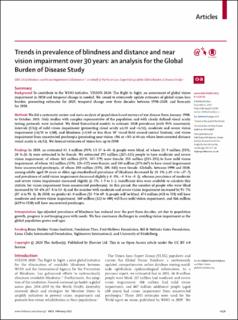| dc.description.abstract | Background
To contribute to the WHO initiative, VISION 2020: The Right to Sight, an assessment of global vision impairment in 2020 and temporal change is needed. We aimed to extensively update estimates of global vision loss burden, presenting estimates for 2020, temporal change over three decades between 1990–2020, and forecasts for 2050.
Methods
We did a systematic review and meta-analysis of population-based surveys of eye disease from January, 1980, to October, 2018. Only studies with samples representative of the population and with clearly defined visual acuity testing protocols were included. We fitted hierarchical models to estimate 2020 prevalence (with 95% uncertainty intervals [UIs]) of mild vision impairment (presenting visual acuity ≥6/18 and <6/12), moderate and severe vision impairment (<6/18 to 3/60), and blindness (<3/60 or less than 10° visual field around central fixation); and vision impairment from uncorrected presbyopia (presenting near vision <N6 or <N8 at 40 cm where best-corrected distance visual acuity is ≥6/12). We forecast estimates of vision loss up to 2050.
Findings
In 2020, an estimated 43·3 million (95% UI 37·6–48·4) people were blind, of whom 23·9 million (55%; 20·8–26·8) were estimated to be female. We estimated 295 million (267–325) people to have moderate and severe vision impairment, of whom 163 million (55%; 147–179) were female; 258 million (233–285) to have mild vision impairment, of whom 142 million (55%; 128–157) were female; and 510 million (371–667) to have visual impairment from uncorrected presbyopia, of whom 280 million (55%; 205–365) were female. Globally, between 1990 and 2020, among adults aged 50 years or older, age-standardised prevalence of blindness decreased by 28·5% (–29·4 to −27·7) and prevalence of mild vision impairment decreased slightly (–0·3%, −0·8 to −0·2), whereas prevalence of moderate and severe vision impairment increased slightly (2·5%, 1·9 to 3·2; insufficient data were available to calculate this statistic for vision impairment from uncorrected presbyopia). In this period, the number of people who were blind increased by 50·6% (47·8 to 53·4) and the number with moderate and severe vision impairment increased by 91·7% (87·6 to 95·8). By 2050, we predict 61·0 million (52·9 to 69·3) people will be blind, 474 million (428 to 518) will have moderate and severe vision impairment, 360 million (322 to 400) will have mild vision impairment, and 866 million (629 to 1150) will have uncorrected presbyopia.
Interpretation
Age-adjusted prevalence of blindness has reduced over the past three decades, yet due to population growth, progress is not keeping pace with needs. We face enormous challenges in avoiding vision impairment as the global population grows and ages. | en_US |

